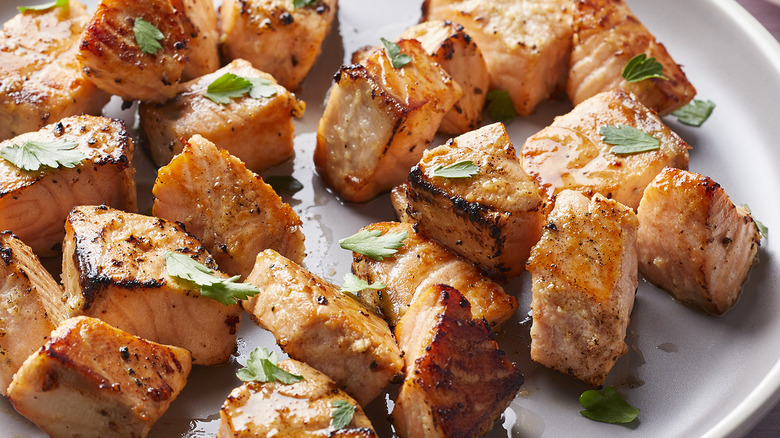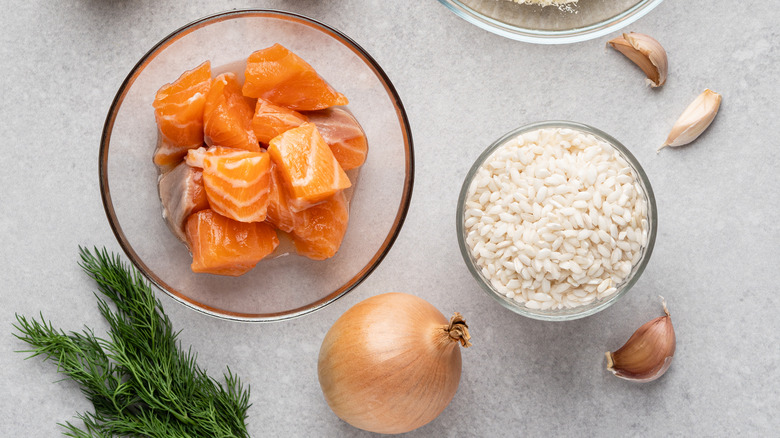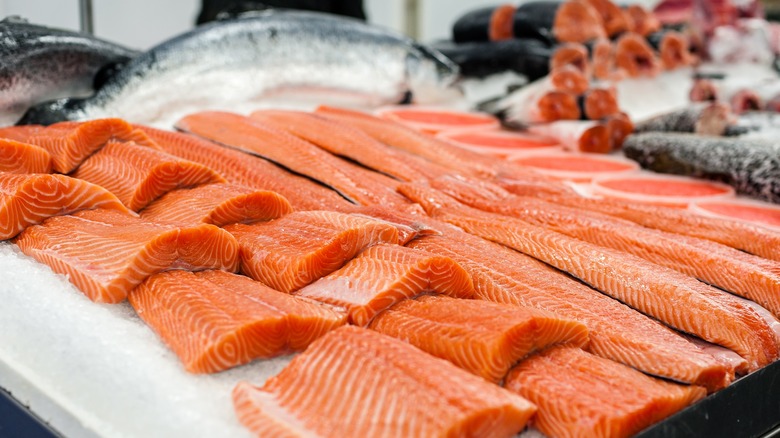Give Your Salmon A Crispy Upgrade By Cooking It In Cubes
Plenty of foods can be cut up into cubes and roasted, pan-seared, or sauteed for ideal bite-sized enjoyment. Of all the foods we tend to cook this way, fish isn't necessarily one that comes to mind.
Most of us are used to cooking and eating fish in its quintessential filet form, sometimes even prepared whole. We roast it in the oven, poach it in a parchment pack, or fry it in a cast iron pan — with some of us fans of crispy skin and others opting for no skin. Something about fish cubes may seem wrong unless they're in a poke bowl...but trust us, it tastes so right.
Especially when it comes to salmon because it benefits so much from crispness. More and more recipes for cubed salmon are going viral today, on TikTok and beyond, and there's a reason: it's a delicious, effective way to prepare this fatty fish we all love.
How cubing can step up your salmon game
Salmon can be prepared in many ways and it's genuinely a matter of preference. But if you long for that sweet spot of perfectly crispy on the outside and perfectly soft and tender on the inside, cubes are the way to go.
Rather than two longer, thinner sides of the fish, cubes give you four sides exposed on every bite, providing the best possible surface area to develop that crispy, crunchy outer layer. If you prefer skin-on salmon, that can work here, but the skin may make it difficult to cut up the salmon, so it's usually removed first. To remove the skin from your salmon filet, Cutco recommends making a small, angled slit on the tail end of the fish to create a flap, then holding the flap while you slice through the flesh to remove the skin. From there, make sure you have a sharp knife to cut your filet into cubes.
The key to cooking cubed salmon is to do so quickly and at very high heat. You can pan-sear the salmon for two minutes on each side, air fry them for five to six minutes, or roast them on high heat in the oven for about 10 minutes, per Babaganosh. Whichever method you choose, it'll only take a few minutes to char the salmon's firm outer flesh to perfection while cooking the inside of each piece just enough, ensuring that it's flaky, tender, and nowhere near overdone.
Tips for buying the best salmon
The higher the quality of the salmon, the better your meal will taste, so it's important to know the best type of salmon to buy and how to select your fish. Salmon that's considered the best quality is (unsurprisingly) usually the most expensive. King salmon (otherwise known as Chinook salmon) is the largest of all and contains more fat and flavor; it's also the rarest species of salmon. Sockeye and steelhead salmon are also great choices that are more affordable. Atlantic salmon tends to be controversial when it comes to its quality and potential contamination.
When choosing your fish, don't be fooled by the color alone. Each type of salmon bears its own varying hue of pink or red, so the brightest color doesn't always mean the best fish. To ensure freshness, look for other things like white lines throughout the flesh, a subtle (not overwhelming) fishy smell, and salmon that's firm to the touch (but not slimy).
The wild vs. farmed salmon debate is a tricky one, and ultimately it boils down to personal preference because there are pros and cons to each. According to Healthline, wild salmon frequently contains more minerals while farmed salmon will often be fed antibiotics, but both are at risk for different contaminants. Farmed salmon is generally more affordable; wild salmon is generally better for the environment. Wild and farmed salmon offer similar health benefits, regardless of their sourcing.


